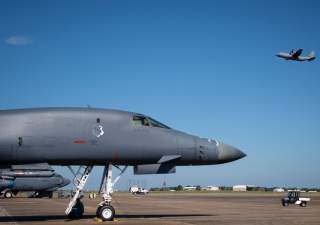In 2017, America's B-1b Lancer Bombers Returned to South Korea yet Again
Two Words: North Korea.
The B-1s then flew over the Korean Peninsula where they were joined by four Republic of Korea Air Force (ROKAF) F-15 fighter jets.
In response to North Korea’s ballistic missile and nuclear programs and as a part of the continuing demonstration of ironclad U.S. commitment to its allies, two U.S. Air Force (USAF) B-1B Lancer bombers under the command of U.S. Pacific Air Forces (PACAF), joined their counterparts from the Republic of Korea and Japanese air forces in a sequenced bilateral missions on Jul. 29, 2017.
According to a PACAF news release, this mission is in direct response to North Korea’s escalatory launch of intercontinental ballistic missiles (ICBMs) on Jul. 3 and Jul. 28.
“North Korea remains the most urgent threat to regional stability,” said Gen. Terrence J. O’Shaughnessy, PACAF commander. “Diplomacy remains the lead; however, we have a responsibility to our allies and our nation to showcase our unwavering commitment while planning for the worst-case scenario. If called upon, we are ready to respond with rapid, lethal, and overwhelming force at a time and place of our choosing.”
Noteworthy after taking off from Andersen Air Force Base (AFB), Guam, the B-1s flew to Japanese airspace, where they were joined by two Koku Jieitai (Japan Air Self Defense Force) F-2 fighter jets.
The B-1s then flew over the Korean Peninsula where they were joined by four Republic of Korea Air Force (ROKAF) F-15 fighter jets. The B-1s then performed a low-pass over Osan Air Base, South Korea, before leaving South Korean airspace and returning to Guam.
Throughout the approximately 10-hour mission, the aircrews practiced intercept and formation training, enabling them to improve their combined capabilities and tactical skills, while also strengthening the long standing military-to-military relationships in the Indo-Asia-Pacific region.
U.S. Pacific Command maintains flexible bomber and fighter capabilities in the Indo-Asia-Pacific theater, retaining the ability to quickly respond to any regional threat in order to defend the U.S. homeland and in support of U.S. allies.
This article by Dario Leone originally appeared on The Aviation Geek Club in 2017.
Image: DVIDShub.

